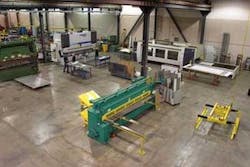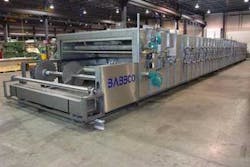C.H. Babb Company (Raynham, MA) has been designing and manufacturing custom baking equipment since 1918. What began as a small family-owned business serving the needs of Northeast bakeries has grown to an internationally recognized maker of high-end tunnel ovens, final proofers, custom conveyors and complete production lines. Sold under the name Babbco Systems, the ovens are used by large wholesalers and industrial bakers to turn out artisan breads, muffins, pizza, bagels, snack foods and other food items.
As one of a few manufacturers of its kind in the U.S., C.H. Babb has historically had a home-base advantage over its competitors, primarily European firms. But as the company's reputation has grown, so has its need to compete on a global scale. To improve its flexibility and efficiency in order to meet the requirements of a broader customer base and further expand its market potential, it turned to laser technology. In November 2001, as part of a move to a new 50,000-square-foot manufacturing facility, the company purchased a CO2 flying optics laser system with integrated shuttle table and 4kW resonator from Strippit/LVD (Akron, NY).
With the addition of a new laser system, the company has eliminated secondary grinding and finishing operations, so laser-cut parts travel directly to bending operations.
The Axel 3015 S laser system replaced high-definition plasma equipment as the primary fabrication method. "We knew we needed a better manufacturing approach," says General Manager Bill Foran. "The laser represented a step up to high speed, high precision." The plasma system's capacity could no longer meet production requirements. Parts often required as many as three subsequent deburring and finishing operations to achieve the high standards for finished quality.
"In the past we had to complete three operations to fabricate our 11-gauge mild steel oven plates," Foran explains. "Typically there are 400 to 600 plates per oven. Now it only takes one operation," he says. "The parts are more accurate and take one-fourth of the time to produce." Most important, plasma technology did not offer the design flexibility that the company felt was critical to its future. "The single most important advantage of the laser is the freedom in design it provides us," says Foran.
Design flexibility is key to C.H. Babb, which markets a "hands-on problem solving" approach as integral to its business philosophy. While Babbco ovens are based on any one or a combination of five different baking methods—direct, indirect, high-velocity air impingement, infrared and radiant tube—the company manufactures an individual solution for every application. Custom designs have ranged from a small 8-foot oven to a 250-foot pizza oven. Considered a high-end product—ovens cost from $150,000 to several millions of dollars—the design versatility adds value to the line. "We're no longer engineering around the limitations of our equipment," says Engineer Paul Novello. "The laser gives us the tool to design a better product for each customer."
Novello points to this example: the company's air oven is designed to transfer heat to the product by convection, creating an even airflow that speeds baking time and provides the baker with greater control over the product's finished appearance and texture. In the past, these ovens presented a challenge because of the time and difficulty to fabricate the intricate shapes. Today, air ovens can be designed and manufactured in a fraction of the previous time.
"We estimate we have cut two to four weeks off the fabrication time," says Foran. "A lot of our customers are building new facilities or replacing old ovens so delivery is very critical. They need to eliminate a lot of downtime. The increased speed in which we can produce these ovens offers our customers a lot of value."
Foran specified a 4kW laser to process stainless-steel components up to 1/2-in. thick, which represents 95 percent of production. The high power gives the company the versatility to cut both thick and thin materials at maximum feed rates. Nitrogen assist gas is used to process parts oxide free and without burrs, eliminating time-consuming finishing operations and producing parts more cost effectively.
A flying optics design allows the cutting head to move freely on three axes. The plate does not move during cutting. The laser is able to achieve high processing speeds regardless of sheet weight or size.
As a result, parts are processed more than 50 percent faster and production has been streamlined so that work pieces move directly from laser cutting to forming operations. Also reduced is the need to replace costly press brake dies that would be scratched or distorted from the slag or dross on the laser-cut part. "We estimate this has saved us several thousand dollars per year," says Foran.
Part accuracy and quality are the result of the system's beam compensation unit, which controls the width of the beam over the entire cutting area. This ensures consistent edge quality throughout the complete work envelope, irrespective of the position of the cutting head on the table. "The accuracy and positioning of the machine combined with accurate control of the beam width gives us consistent high-quality output," says Foran.
"Time is of the essence," says Foran. "In the past we had to outsource a number of components and couldn't control our delivery dates or product quality on components produced outside. We've significantly reduced outsourcing and no longer face those issues." The laser has also helped the company reduce scrap. "We have never had to throw out any parts produced on the laser," Foran reports. "We can cut out complex shapes quickly and easily. If you started cutting badly with our previous equipment, you generally had to scrap the entire piece."
C.H. Babb's direct-fired tunnel oven Model A108/80 is 80 feet long and 108 inches wide (useable dimensions). The first eight feet of the oven use a tube burner steam section for baking while the remainder of the oven utilizes direct-fired ribbon burners for baking.
The laser features a built-in capacitive height sensor that automatically compensates for any unevenness in the material without operator intervention. Its shuttle design allows one table to be loaded while the machine is cutting on the other table, maximizing uptime. "The laser setup is simple. A vacuum-type lifting system loads the sheet to the machine," Foran explains. "The laser finds the edges of the sheet and squares it up."
C.H. Babb uses the system's Laser Eye, which provides fast, accurate, contact-free measurement of reference points from sheet edges or pre-punched holes. With this information, the control triangulates the exact coordinates to locate the position of the work piece or fixture.
The company has operated the laser in a lights-out fashion but does so only when handling heavily nested parts. The accuracy, speed and automated material handling features of the laser have helped it control product costs. Reportedly, a custom Babbco oven is often less costly than an off-the-shelf counterpart.
C.H. Babb's improved efficiency is also credited to the use of an offline programming system that integrates laser cutting and bending operations. "Software was an important part of our decision," adds Foran. "We wanted to go from our part drawing to the part program and eliminate the opportunity for human error throughout the process. The efficiency and ease of use of the software has reduced programming time and minimized mistakes," he says.
The software allows the programmer to import 2D and 3D DXF and IGES files or scanned drawings and it reduces cutting time by maximizing the cutting parameters for the contours and shapes, and optimizing the piercing and cutting head height and positioning path. Automatic nesting and common-line cutting are other features Foran employs to maximize material usage. The user can configure lead-ins/lead-outs for different contours depending on the material and thickness. Other advanced features include cutting path optimization and high-speed communications.
While other manufacturing firms have felt the impact of a down economy, C.H. Babb's business has continued its steady growth. Unique designs and the tools to produce high-quality custom ovens keep the company rising above its competitors. "Our ability to customize ovens continues to set us apart from our competitors," says Foran. "It's our job to create new designs and to use current machine tool technology to do so," says Novello. "It benefits us and our customers."
Steve Crane is an engineer with the Laser Division of Strippit/LVD, Akron, NY. For more information on Strippit/LVD lasers, visit www.lvdgroup.com. Learn more about C.H.Babb on its web site, www.chbabb.com.

